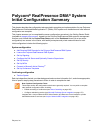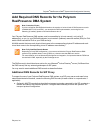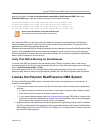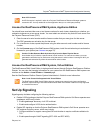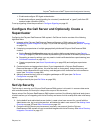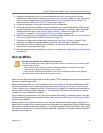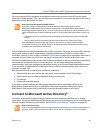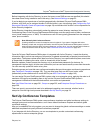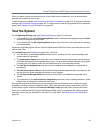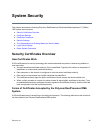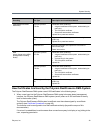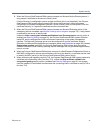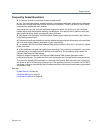
Polycom
®
RealPresence DMA
®
System Initial Configuration Summary
Polycom, Inc. 37
Before integrating with Active Directory, be sure that one or more DNS servers are specified (this should
have been done during installation and initial setup). See Network Settings on page 63.
If you’re deploying a supercluster of multiple geographically distributed Polycom RealPresence DMA
clusters, verify that you’ve assigned clusters to the territories in your site topology (see Configure the Call
Server and Optionally Create a Supercluster on page 34) and decide which cluster is to be responsible for
Active Directory integration.
Active Directory integration automatically makes the enterprise users (directory members) into
Conferencing Users in the Polycom RealPresence DMA system, and can assign each of them a conference
room (virtual meeting room, or VMR). The conference room IDs are typically generated from the enterprise
users’ phone numbers.
Once the Polycom RealPresence DMA system is integrated with Active Directory, it reads the directory
information nightly, so that user and group information is updated automatically as people join and leave the
organization. The system caches certain data from Active Directory. In a superclustered system, one cluster
is responsible for updating the cache, which is shared with all the clusters.
Between updates, clusters access the directory only to authenticate passwords (for instance, for
management interface login); all other user information (such as user search results) comes from the cache.
You can manually update the cache at any time.
Enterprise groups can have their own conference templates that provide a custom conferencing experience
(see Conference Templates on page 190). They can also have their own MCU pool order, which
preferentially routes conferences to certain MCUs (see MCU Pool Orders on page 145).
You can assign Polycom RealPresence DMA system roles to an enterprise group, applying the roles to all
members of the group and enabling them to log into the Polycom RealPresence DMA system’s
management interface with their standard network user names and passwords.
See User Roles Overview on page 301, Groups on page 325, and Enterprise Groups Procedures on
page 329.
There are security concerns that need to be addressed regarding user accounts, whether local or
enterprise. See the high-level process described in Set Up Security on page 34.
Set Up Conference Templates
The Polycom RealPresence DMA system uses conference templates and global conference settings to
manage system and conference behavior, and it has a default conference template and default global
conference settings.
After you’ve added MCUs to the system, you may want to change the global conference settings or create
additional templates that specify different conference properties.
If you integrate with Active Directory, you can use templates to provide customized conferencing
experiences for various enterprise groups.
Note: Manually Add Conference Rooms
Creating conference rooms for enterprise users is optional. If you want to integrate with Active
Directory to load user and group information into the Polycom RealPresence DMA system, but don’t
want to give all users the ability to host conferences, you can do so. You can manually add conference
rooms for selected users at any time. See Conference Rooms Procedures on page 323.



